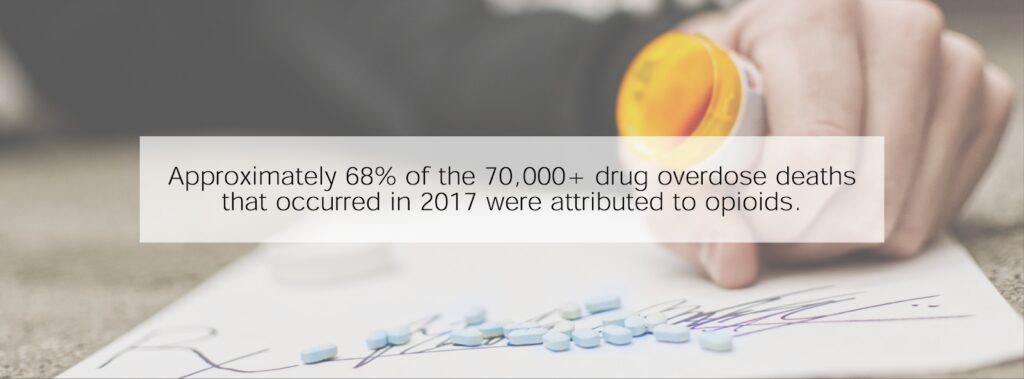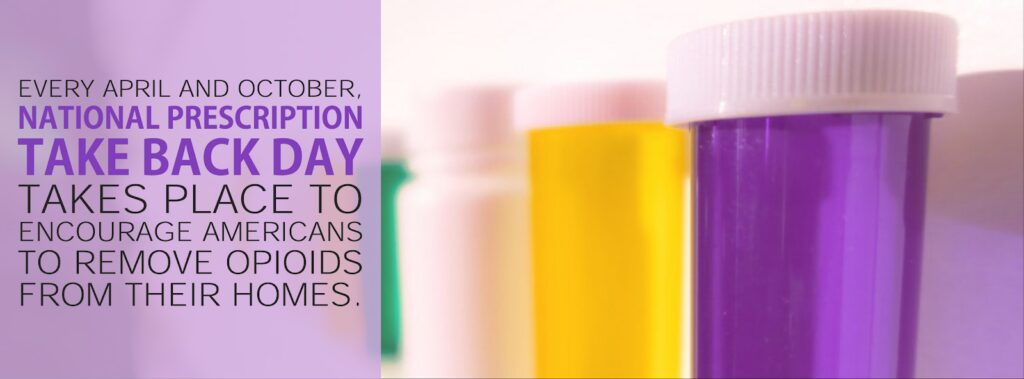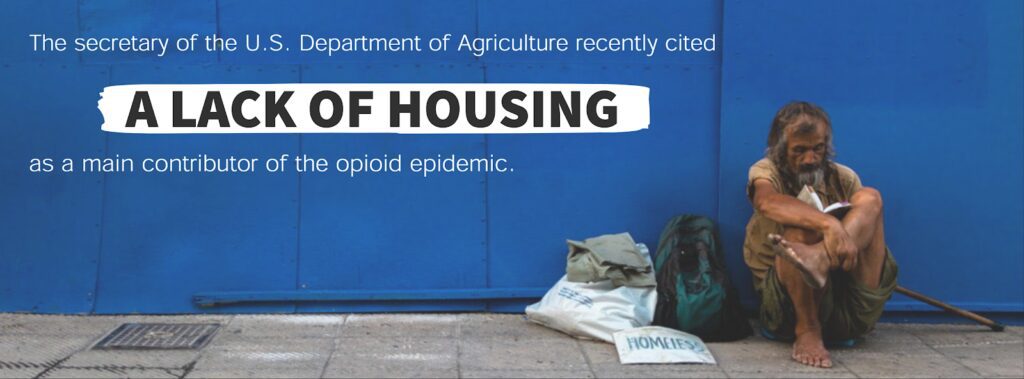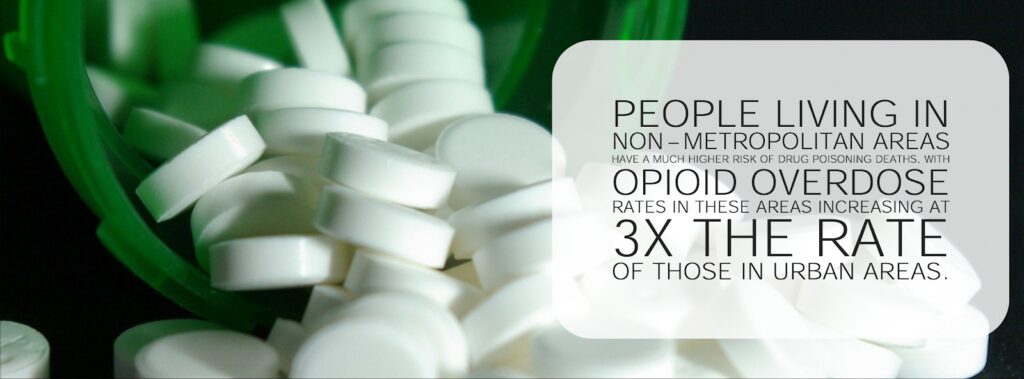The United States has been grappling with an addiction crisis -- specifically fueled by a growing abuse of prescription opioids -- for the last several years. Medical providers were initially assured that opioid pain relievers wouldn’t pose a threat of addiction, which prompted a substantial increase in the prescriptions being dispensed for these medications. This has led to widespread use and misuse of opioids, which has had drastic consequences for countless Americans.
Before physicians and other medical professionals realized the dangers associated with these drugs, the nation had found itself in the center of a public health emergency. According to the U.S. Centers for Disease Control and Prevention, approximately 68% of the 70,000+ drug overdose deaths that occurred in 2017 were attributed to opioids. What’s more, the number of opioid-related overdose fatalities that occurred that year was six times higher than the same types of deaths that occurred in 1999. In less than a decade, opioid addiction has spiraled out of control. In fact, roughly 130 Americans die each day as a result of opioid overdoses -- and that doesn’t factor in the 11.4 million people who misused prescription opioids in 2016 alone.

Of course, federal and state government agencies are trying to do their part to end the opioid crisis. The U.S. Department of Health and Human Services has provided substantial grants to support prevention, treatment, and recovery, as well as allocating funds to overdose reversing medications to save lives and to prioritize consistent research in order to beget updated data. But while these initiatives are essential, they aren’t the only important steps that must be taken to fight this threat to public health and safety. Local agencies, businesses, charitable organizations, activists, and others are taking matters into their own hands to combat addiction. While these efforts may not involve extensive legislation or sweeping reform, they have the power to facilitate real change and provide improvements for Americans who are struggling.
Every April and October, National Prescription Take Back Day takes place to encourage Americans to remove opioids from their homes. This initiative can reduce the risk that these highly addictive medications might be stolen and/or misused by friends, relatives, and visitors. The U.S. Department of Justice’s Drug Enforcement Administration has collected nearly 11 million pounds of unused, unwanted, and expired prescription medications through its free and anonymous events that occur nationwide. In 2018 alone, the American public turned in 914,236 pounds of prescription drugs at the DEA’s 5,800 sites around the nation. The DEA partners with local organizations to provide authorized site locations throughout the United States, ensuring that all Americans can access this vital service.

The DEA isn’t the only organization that wants to spread the word about safe drug disposal practices. Many well-known pharmacies, such as Walgreens and CVS, have their own drug drop boxes to ensure medication is disposed of in a safe way. These kiosks are conveniently located where many patients already pick up their prescriptions, which means that Americans can get rid of unsafe, unwanted, or unnecessary medications even when a drug take-back day isn’t taking place. Many hospitals and other healthcare facilities also offer disposal services, while mail-back programs can provide yet another way for American consumers to dispose of their drugs through the U.S. Postal Service.
Both private companies and government agencies provide valuable information for consumers regarding the best methods for safe drug disposal. Although the aforementioned methods are typically recommended, the U.S. Food and Drug Administration does provide guidelines for those who would rather dispose of their prescription drugs at home. There are a select number of drugs (such as fentanyl and hydrocodone) that should be flushed down the toilet due to the hazards involved. When there are no specific instructions included and there are no take-back programs available in your area, the majority of prescription medications can be tossed out in the household trash. However, these medications should be mixed in (but not crushed) with a substance like cat litter, dirt, or used coffee grounds prior to disposal. This mixture should be put into a sealed bag or other container, which should then be put into the garbage. Any information on prescription bottles should be scratched out before disposing of these containers. The National Association of Boards of Pharmacy can offer additional resources on safe drug disposal.
Of course, pharmaceutical manufacturers must do their part to ensure that consumers know how to dispose of these medications and when it’s time to do so. Aside from the prescription opioids that patients may no longer need or want to have in their homes, improving customer knowledge pertaining to the shelf life and intended use of all prescriptions should be a top priority for manufacturers and distributors. Ultimately, this comes down to providing straightforward and compliant information on pharmaceutical packaging and labeling. When consumers can instantly know whether their medications are safe for them to use or whether it’s time to dispose of them through a drug take-back program, this promotes improved public health and brand trust. Many pharmaceutical companies will also offer information about safe disposal methods right on the packaging or labeling for these same reasons.
At first glance, the opioid crisis might not seem to have much to do with America’s lack of housing. But according to many experts, the two problems are intertwined. Smaller cities and rural areas are especially vulnerable to opioid addiction, and it’s no coincidence that these areas also tend to have inadequate housing infrastructure. In fact, the secretary of the U.S. Department of Agriculture recently cited a lack of housing as a main contributor of the opioid epidemic. Research from the National Institutes of Health revealed that people living in non-metropolitan areas have a much higher risk of drug poisoning deaths, with opioid overdose rates in these areas increasing at three times the rate of those in urban areas. Not only do those living in larger cities have access to resources that can help individuals combat addiction, but they also have more visible programs to combat homelessness and provide affordable housing.

As a result, the USDA recently came up with a plan to provide funding for transitional housing for those in treatment for opioid addiction in 22 different states. But this government agency isn’t the only one working to provide access to housing in order to prevent opioid addiction and facilitate recovery. According to the Corporation for Supportive Housing, a non-profit organization that uses housing as a means of improving quality of life for vulnerable populations and growing healthy communities, the resources allocated by many agencies tend to ignore how homelessness plays into addiction.
In CSH’s report, “Supportive Housing: An Opioid Crisis Solution,” the organization states: “To be effective, addiction treatment systems need to address the needs of these very vulnerable people not yet engaged in recovery, as well as persons who, while engaged in recovery, may also suffer from multiple disabilities beyond addiction. The homelessness sector is experienced in working with such vulnerable populations and has found that for a portion of persons with multiple disabilities, supportive housing is the solution to effectively stabilize and promote recovery to improve lives.”
In other words, organizations on the state and community level need to make careful decisions about how housing resources are allocated to benefit those who are struggling with substance abuse, including prescription opioid misuse. While there are many initiatives that make sobriety a prerequisite for securing housing, there are other entities (like Housing Works) that focus on providing homes first so that individuals can then receive the services they need. The Luminer Foundation is just one of many organizations that devotes funding to combat homelessness and ensuring the accessibility of treatment and other programs to improve overall quality of life. Once individuals are in a safe and stable environment, they are able to have greater aspirations for themselves and pursue treatment that can facilitate recovery.

The opioid epidemic can’t be blamed entirely on misunderstandings surrounding addiction, but the social stigma certainly doesn’t help. Because the conversation surrounding substance abuse often promotes feelings of shame, guilt, weakness, and lack of self-worth, this narrative often perpetuates the cycle of addiction. What’s more, shrouding these problems in secrecy and mystery only makes it harder for individuals to recognize when it’s time to get help.
The reality is that drug abuse doesn’t discriminate; regardless of age, gender, or background, the potential for addiction exists, particularly when opioid medications have been made so readily available. Adolescents, young women, and even seniors are all showing increasing rates of prescription drug abuse, though virtually anyone may be inclined to misuse these powerful and highly addictive medications.
In the end, increasing the visibility of drug abuse and recovery, as well as highlighting the immediate need for widespread change, can make a huge difference in the way the opioid crisis plays out. Many activist groups are shifting the conversation from merely focusing on awareness to putting pressure on organizations and agencies to make their own sizeable changes. Humanizing addiction and recovery are the first step, while putting pressure on elected officials and organizations to devote funding to prevention and recovery services act as the second. But in order to convince politicians and others in power that these causes are worthy of financial backing, reducing the stigma around addiction is essential. From popular rallies to social media campaigns, the conversations are happening -- though the battle is certainly an uphill one.
Healthcare professionals and other organizations are also realizing the harm of over-prescribing opioids. While there are many patients who have a legitimate need for acute or chronic pain management, there’s a growing emphasis on finding alternative treatments that pose no risk of addiction or death. Many Medicaid programs, for example, are now covering alternative treatments like yoga, massage therapy, chiropractic adjustments, physical or behavioral therapy, and acupuncture in the name of pain management. While these programs have their critics and their skeptics, greater accessibility to these services may reduce the reliance on prescription opioids and, therefore, the misuse of these medications in some cases. In states where these programs aren’t covered, individual providers may choose to ensure patients can access their services (often, on their own dime) to do their part in reducing opioid dependence.
There is no one solution that will put a stop to the opioid epidemic in America. While opioids were once seen as a magic pill to cure what ails you, it’s now clear that there’s no such thing -- and when we believe it exists, it’s likely to do more harm than good. But by embracing a variety of initiatives, it’s possible to promote education, understanding, safety, and sizeable change.